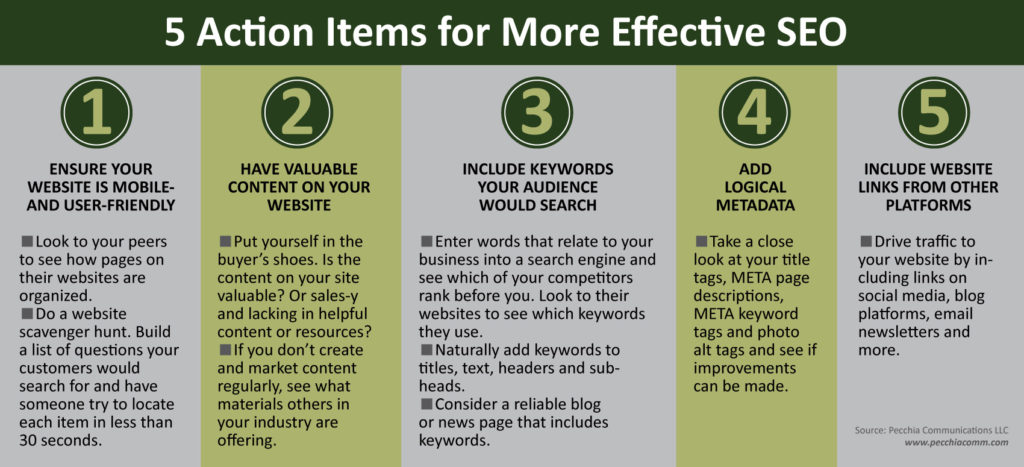25
2019
By Kelli Hulea
Think of search engine optimization as a digital phonebook or billboard — on steroids.
If you want people to know what you offer, they need to be able to find your business online. Ranking high in search results doesn’t happen overnight. It’s more of a marathon effort than a sprint.
Therefore, you need to exercise and stay sharp in these five key areas for search engines to recognize your website and content as relevant and valuable.
- Be sure your website is mobile- and user-friendly.
- Add content on a regular basis.
- Use keywords in a natural way.
- Don’t ignore metadata.
- Use links to your website from other platforms.
Here are questions you need to ask yourself and ways to get started.
1. Is my website mobile-friendly? Can users find what they’re looking for?
If you’re unsure, visit your website from a mobile device and see how easy it is to navigate. If you have to zoom in and out to see different parts of the page and the text is microscopic, you’re due for a website update.
Search engines use algorithms to determine user-friendliness. It hurts your ranking if visitors leave your site almost immediately.
You should consider what is most important to visitors and think about how they would search for it. This will determine where and how you organize your pages under the main navigation menu on the home page.
How to get started:
- Look to your peers. Take notes on the organization of pages from others in your industry.
- Utilize a website scavenger hunt. Put together a list of questions or items that your customers would be interested in and have someone who is unfamiliar with your website try to locate these items. If it takes them more than 30 seconds to find any of them, then you should reconsider your organization.
2. Does my website have content that my audience would find valuable?
Consider how your content is meeting the needs of your audience. Does it make sense to have blog articles, whitepapers, videos, product guides or other informative materials?
If you continuously add or update items on your website, search engines view it as being up-to-date and relevant, which can improve your ranking over time.
How to get started:
- Put yourself in the buyer’s shoes – Take a look at your website from a customer standpoint and see if you feel like you’re receiving valuable information/content. If it seems sales-y and lacking in valuable content or resources, then you should consider improvements in your content.
- If you don’t already implement content-marketing efforts, perform a competitive analysis and see what materials others in your industry are offering their customers.
3. Does my website include keywords that my audience would search for?
What would your prospective customers search for to end up on your website? These are the keywords you should incorporate across the front and backend of your website.
How to get started:
- Do a local keyword search. Go to a search engine and enter words that relate to your business with the name of your city following and see which of your competitors rank before you. Look to their websites to see which keywords they include on their websites and where.
- Naturally add keywords to titles, text, headers and subheads on individual pages.
- Consider developing a reliable blog or news page that includes keywords.
4. Does my website include metadata descriptions?
Metadata are the behind-the-scenes descriptors that algorithms look at. These can include title tags, META page descriptions, META keyword tags and photo alt tags, which can all be found on the back end of your website. Be concise when writing your metadata, as search engines generally look at a limited amount of characters.
How to get started:
- Draft metadata descriptions by using keywords to the places mentioned above. For example, do not name your image file “image01,” but use a keyword instead.
5. Do I use other platforms to link to my website?
If you put links to your website in front of more people, you’ll be more likely to attract visitors. If you have strong website traffic, your organic search ranking will be stronger, because search engines will see your website as useful.
How to get started:
- Think of different ways you can drive traffic to your website from social media, separate blogging platforms, email newsletters and more through the use of links.
Keep Running the SEO Marathon
Algorithms are always changing and there is no way to know the ultimate SEO practices because they change often. But you can stay informed and practice these five exercises on a regular basis to remain competitive in the organic ranking race.
# # #
Kelli Hulea is a project manager with Pecchia Communications, which helps its clients assess and improve SEO tactics. To learn more, contact Kelli at kelli@pecchiacomm.com.
Latest Posts
- 3 Media Relations Guidelines for an Era of Growing Distrust May 5, 2025
- Brighten Up Your Brand: 3 Tips for a Summer Messaging Makeover May 5, 2025
- Pecchia Comm Lands 18th Major Change Engagement May 5, 2025
- Student Journalism Awards Lead Press Club’s Plans for 2025 March 6, 2025
- Pecchia Comm Plans $20K Grant to Celebrate 20th Anniversary February 26, 2025
- Power of Print Still Endures in Employee Comms February 5, 2025
- 6 Essential Communications Strategies for Managing Organizational Change February 4, 2025
- Factory Work Instructions Drive Compliance, Consistency February 3, 2025
6725 Pheasant Run Drive | Youngstown, Ohio 44406 | Privacy Policy


